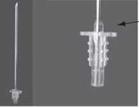Whilst this might seem obvious, it is essential that there is sufficient adhesive to fill the joint. Joint starvation can often be the reason for poor joint strength. In some applications air voids and cavities can often mean the difference between a ‘good’ or ‘bad’ joint, especially if the adhesive is required to act as a sealant as well as an adhesive. In clear plastic components, the inspection technique should be relatively straightforward but with opaque plastics it can be difficult to ascertain whether the adhesive has fully filled the joint.
Visual inspection of a failed component is usually the first step to determine the quantity of adhesive in the joint. Some adhesives will fluoresce under ultraviolet (UV) and this will aid the inspection process but if the adhesive is a very similar colour or texture to the substrate then a more careful or complex inspection technique may be required. One such method is to use Fourier transform infrared (FTIR). FTIR methods can identify individual elements of both the substrate and the adhesive and
therefore define exactly what is present on the surface but the assistance of the adhesive manufacturer may be required to disclose the formulation of the adhesive polymer.
For clear joints, adhesives with a fluorescent agent can be used to simplify the inspection technique and in the medical industry this property is widely utilised.
 |
 |
Adhesives are used to bond the stainless steel cannulae to the plastic hubs (Figure 10.1) and in this high-volume application (up to ten assemblies per second) it is essential that every needle assembly is bonded. The adhesive used (typically either a UV acrylic or a single-part epoxy) fluoresces at about 450 nm and so the presence of adhesive on the cannula can be verified automatically using inspection cameras and if it does not ‘see’ the adhesive fillet, it will eject the part off the line.
Figure 10.1 Bonding a cannula to a hub
With opaque plastics, a fluorescent adhesive can still be used but the camera would be set to inspect the component parts before the joint is closed.
 7 января, 2016
7 января, 2016  Pokraskin
Pokraskin  Опубликовано в рубрике
Опубликовано в рубрике 